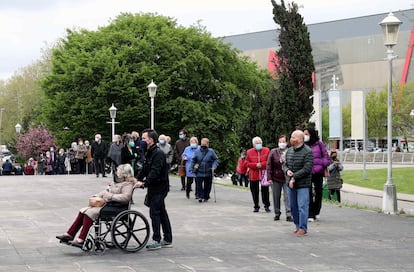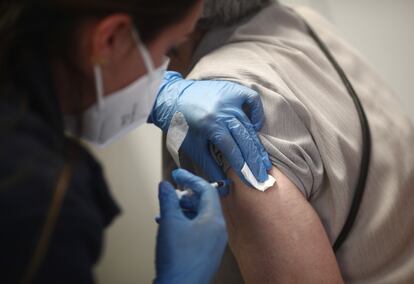Spain’s Covid-19 vaccination drive maintains pace despite Easter break
The regions are administering nearly all the doses that have arrived, meaning speeding up the rollout will depend on the production capacity of pharmaceutical companies

Spain’s regions managed to administer nearly 1.3 million Covid-19 vaccines between March 30 and Tuesday, according to the Health Ministry. That figure is similar to that of the seven previous days, when 1.25 million shots were injected, which suggests that the campaign was not slowed down by the Easter break. But this pace will not be enough to hit the central government’s targets: the current speed is equivalent to 600,000 people a week, while 1.4 million will be necessary if 70% of the adult population is to be vaccinated by September.
The data supplied on Tuesday by the Health Ministry indicate that, to be precise, 1,284,390 doses have been administered in the last seven days, compared to 1,249,531 shots the week before. During the vaccination campaign so far, 9,021,001 doses have been injected, while 2,902,291 people have received the two shots necessary for the full protection offered by the vaccine. A further 6,118,710 people now have at least one dose, which is important given that a single shot has been shown to offer a high level of protection from Covid-19.
The number of people who have already been vaccinated shows that the regional governments are moving forward without keeping hardly any of the vaccines in reserve. After its use was briefly suspended due to fears over blood-clot cases, the Oxford-AstraZeneca vaccine is once again being used in Spain. What’s more, now that it has been shown that the second dose can be delayed with no effect on the protection offered by the vaccine, Spain’s regions are opting to vaccinate as many people as possible with the first dose.
The latest report from the ministry shows that more than 93% of the vaccines it has sent to the regions until Monday have been used, although the percentage falls to 75.7% if the 2.2 million shots sent on Tuesday are taken into account – of course, there has not yet been time to administer these doses, nor even defrost them. What’s more, as the campaign has progressed, differences in the rate of administration from region to region have evened out, and practically all of Spain’s territories are administering all of the vaccines that they are receiving.
According to the latest data, more than 93% of the vaccines sent to the regions have been administered
The speed of the campaign is still slow, however, as Fernando Simón, the director of the Health Ministry’s Coordination Center for Health Alerts (CCAES), admitted on Monday. “We could absorb a lot more vaccines if we were to receive them,” the government’s chief epidemiologist said. He cited the country’s flu shot campaign, during which as many as 14 million people were vaccinated in seven weeks “without making a major effort.” In fact, that rate of two million doses a week has still not been reached with the Covid-19 vaccines.
The aim now is to roll out the immunization process to groups of younger people, who are easier to assemble at mass-vaccination sites and have fewer risks. What’s more, the Janssen vaccine – which has been approved by the European authorities for use but is not yet being administered in Spain – requires just one shot and does not need to be stored at extremely low temperatures. The use of this medication will help to speed up the process.
On March 31, the Health Ministry began to supply information on the campaign broken down by age group. The latest report shows that the majority of people who have already received the two doses are the over-80s (1.3 million people of the 2.2 million who have full protection), followed by 750,000 people aged between 25 and 49, from the essential workers group (teachers, police officers, healthcare workers, etc.).

With this data, the question still remains as to whether 33 million people can be vaccinated before September, as Spanish Prime Minister Pedro Sánchez promised on Tuesday at a press conference. The milestones for the campaign, however, rely on a constant supply of doses. In the nearly three-and-a-half months since the process began on December 28, there have been two major interruptions to the supply chain. The first came in January, when Pfizer closed a plant in order to increase its capacity. And the second, and which had a much greater effect, was due to the problems that AstraZeneca is having to produce the vaccines at the agreed rate.
Speaking on Tuesday, Sánchez blamed the British-Swedish company for the delays to the process in the European Union.
Given the problems with the supply, the EU has readjusted its purchasing calculations. It should be pointed out that Spain is not acquiring the vaccines itself but rather via a European mechanism, by which it is due approximately 10% of all the supply acquired by the European Commission. Even after these cuts in supply are taken into account, Sánchez’s objective appears feasible.
A total of 2,902,291 people have received the two shots necessary for the full protection offered by the vaccine
On Tuesday, speaking with more clarity than the country’s health ministers had done previously, Sánchez set the clear objective of vaccinating 70% of Spain’s adult population before the end of the summer – or to put it another way, 33 million people.
And the calculations suggest this can be done. For the second quarter of the year, which has just begun, more than 300 million two-dose vaccines are expected to arrive in the EU, which would be enough to immunize 150 million people – of whom around 15 million will be in Spain. What’s more, Janssen should be delivering 55 million doses to the EU, which will mean 5.5 million fully vaccinated Spaniards given that this medication requires just one shot to offer full protection.
This means that Spain could have immunized around 30 million people by the end of June should all of the targets be met – and that would leave another two months to meet the objective that Sánchez set on Tuesday. Although the European Commission does not have a detailed estimate of how many doses it will receive going forward, if nothing changes from the second quarter to the third, Spain could vaccinate a further 13 million people, when just three million would be sufficient to hit the prime minister’s target by the end of August. In the meantime, other manufacturers – such as Curevac and Sputnik – could enter the market, which would ramp up the speed even further. The other factor, of course, is that the regional healthcare systems have the capacity to administer all the doses. Until now, they have been more than up to the task.
English version by Simon Hunter.
Tu suscripción se está usando en otro dispositivo
¿Quieres añadir otro usuario a tu suscripción?
Si continúas leyendo en este dispositivo, no se podrá leer en el otro.
FlechaTu suscripción se está usando en otro dispositivo y solo puedes acceder a EL PAÍS desde un dispositivo a la vez.
Si quieres compartir tu cuenta, cambia tu suscripción a la modalidad Premium, así podrás añadir otro usuario. Cada uno accederá con su propia cuenta de email, lo que os permitirá personalizar vuestra experiencia en EL PAÍS.
¿Tienes una suscripción de empresa? Accede aquí para contratar más cuentas.
En el caso de no saber quién está usando tu cuenta, te recomendamos cambiar tu contraseña aquí.
Si decides continuar compartiendo tu cuenta, este mensaje se mostrará en tu dispositivo y en el de la otra persona que está usando tu cuenta de forma indefinida, afectando a tu experiencia de lectura. Puedes consultar aquí los términos y condiciones de la suscripción digital.
More information
Últimas noticias
From safe-haven investment to geostrategic weapon: Who owns the most gold and where are the bars kept?
Todd Green, head of the company that created ‘Candy Crush’: ‘Success for us is that players want to play for years’
Prices soar and Venezuela’s economy struggles under Trump’s pressure: ‘People are living day to day’
Magnets in their heads: How some animals guide themselves using the Earth’s magnetic field
Most viewed
- Why we lost the habit of sleeping in two segments and how that changed our sense of time
- Charles Dubouloz, mountaineering star, retires at 36 with a farewell tour inspired by Walter Bonatti
- Venezuela faces its most tense Christmas yet
- CBS in crisis after pulling a report on Trump’s deportations to El Salvador (which later leaked online)
- Bukele clan fumes over investigation exposing their new wealth








































